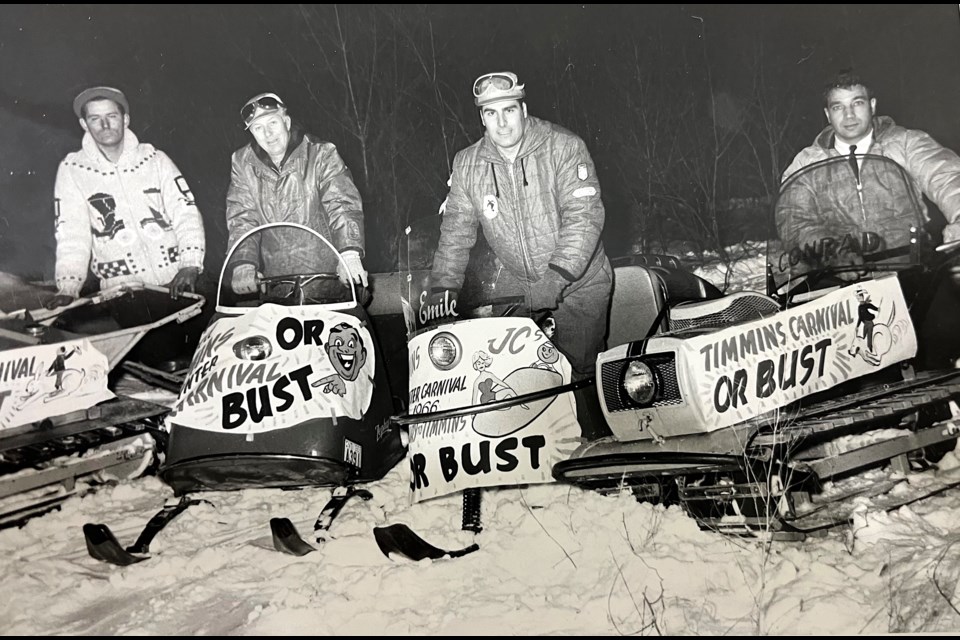Today, Northern Ontario’s wilderness can be treacherous, even for hardy adventurers.
Turn the clock back 50 years or so. It’s a time before cellphones, global positioning systems and instant weather updates.
And you needed a strong arm to start a snowmobile.
A group of Timmins men made it their mission to promote the sport of snowmobiling and local winter festivals by making long-distance treks through the North on their snow machines. They were the Sno-Pros.
In 1966, the group made a 160-mile trip (257.5 km) from Sudbury to Timmins, promoting the Timmins Winter Carnival. In 1967, they made a 98-mile (157.7 km) return trip from Foleyet to Missonga. And in February 1968, they snowmobiled from Timmins to Gogama, a 136-mile (219 km) return trip.
Five die-hard snowmobile enthusiasts — Emile Demers, Conrad Bisson, Luke Venne, Red Arbique and Lionel Belair — went on a record-setting journey in March of 1968. The trip was described in the March 1998 edition of The Golden Citizen.
The Sno-Pros challenged a world record for a non-stop, cross-country snowmobile run, going from Timmins to Sudbury and back. It was a trip of about 320 miles {515 km) and was part of the Timmins Winter Carnival.
They left the Cache at Kenogamissi Lake on a Saturday at 7 a.m. and planned to return around 2 p.m. Sunday.
They believed going down would be the toughest part of the record bid. The Sno-Pros knew they would have to break the trail in several areas. This meant stopping and tramping on the snow to make it passable for their machines.
“We were really racing time and distance,” Demers said.
Their route was along Kenogamissi and Mattagami Lakes, along hydro lines and over bush roads to Hanmer. A 45-gallon drum of gas was placed in advance at Westree, the midway point of the trek. Each driver also carried approximately seven gallons of gas on their machine.
One machine was equipped with an odometer to record the mileage. Ontario Hydro recorded the time. The Sno-Pros reported their progress by phone from hydro stations along the route.
They used snowshoes to break trails up hills. The team also carried sleeping bags, spare parts and food for emergencies.
The group arrived at the Woodland Hotel in Hanmer at 5:15 p.m. Saturday — a time of 10 hours, 43 minutes. They stopped for about 90 minutes to eat, dry their clothes and buy fuel. Then the Sno-Pros headed back north.
That’s when they ran into a snowstorm and heavy drifting.
“We were travelling back at night too, so that really slowed us up,” Demers said. “We had to rebreak the trail. It was so stormy in Hanmer that the OPP didn’t want us to leave. There were winds up to 35 mph. The only problems we had were two burned spark plugs.”
The heavy snowfall caused headaches for the group.
“We got lost near Laforest Road and lost about 10 miles,” Arbique said. “Luckily, we met some fisherman and they put us on the right track.”
The Sno-Pros set a new record for non-stop distance travelled, but not the distance/time mark. That record was held by American Ralph Plaisted, who rode 252 miles in 13 hours and 52 minutes.
One year later, the Sno-Pros planned a 500-mile (805 km) weekend trip from Timmins to Moosonee and back. The group added a new member, Rolly Secord.
The planned route was from the Shell Car Clinic north on Rea Street through the bush to Highway 655, following hydro lines across Highway 11, up through Hunta to Otter Rapids, where a fuel depot was set up. From there, the Sno-Pros were to tackle bush roads and other routes.
When they left Highway 655, the group experienced snowmobile breakdowns, mainly clutch and carburetor problems.
They quit after 107 miles. Trucks were sent to Fraserdale to pick up their machines.
This setback did not deter the Sno-Pros.
In February 1970, the group planned a ride to Espanola for the Espanola Winter Carnival. It would be about a 500-mile (805 km).
Paul Guiho joined them that year.
They left Timmins at 5 a.m. on Friday, Feb. 6, arriving at the festival before noon Saturday. They were back in Timmins on Monday morning.
The last trip made by the Sno-Pros was their most ambitious, more than 1,000 miles (1,609 km) to Fort Albany and back in 1971.
They left Thursday morning March 25 and reached Fort Albany by mid-afternoon Saturday. Members attended the winter carnival in Fort Albany and planned to start back on Monday morning. But they turned back after only 14 miles, as they hit a snowstorm with visibility reduced so much they couldn’t see the skis on the front of their machines. Winds were estimated at 55 mph.
They left on Tuesday instead and sledded straight to Fraserdale, where they camped overnight.
On Wednesday morning, they left Fraserdale, arriving at Timmins about 5 p.m. They were greeted by a large crowd of friends and relatives to mark a successful grand finale.
During their five years of Sno-Pro, these men went more than 4,000 miles (6,437 km) through the wilderness in the dead of winter. Today, snowmobilers can enjoy more than 30,000 km of groomed trails throughout the province thanks to the Ontario Federation of Snowmobile Clubs and its members.
They were true Northern trailblazers, in a less automated and more rugged time.
The spirit of the Sno-Pros lives on, every time friends plan and take winter vacations on some of the world’s best snowmobile trails in Northern Ontario, five decades later.
